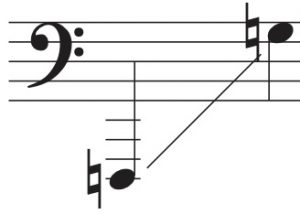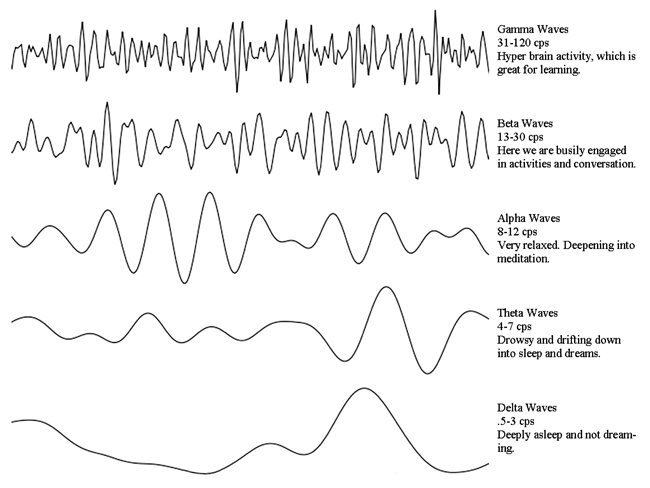
Perform this score in a dream
Mentally rehearse before sleeping to embed it into unconscious intention
Rehearse from dream to dream
Refine as much as possible
- The graphic score consists of a series of dials that resemble clocks. Just like a clock they are numbered from 1 to 12, with 2 hands (big and small) that point towards numbers.
- The position of the big hand indicates how many sounds to make on the recorder. 12 = 12 sounds, 11 = 11 sounds, 10 = 10 sounds, 9 = 9 sounds, and so on. A single sound is whatever sound is made on the recorder that has a demarcation before and after it. The sounds can be different from each other, or the same. The spacing between each sound should be irregular wherever possible.
- The position of the little hand indicates the time in which to make the sounds. 12 = 12 seconds, 11 = 11 seconds, 10 = 10 seconds, 9 = 9 seconds, and so on.
An example in the score is: 5, 2″ – which means play 5 sounds in 2 seconds.
- The blue lines represent sounds that are breathier and uses flutter tonguing. The red lines have sharper attacks and are grittier.
– – – – – – – – – – Follow the dotted line. Start where it says the word “start” and play the nearest clock. Once you finish, follow the dotted line to the next clock and play that. Keep doing this, following the dotted line until it finishes, which is the end of the piece.
This is the pitch range of the sub-contrabass recorder in F1, which is the one used in the graphic score above.
Dynamics and duration
The size of the symbol indicates how loud to play it (a suggested dynamic has been written underneath as well). The player needs to estimate the pitch and the dynamics based on the relative size and position of the symbols. Try to keep the dynamic range between pppp–mp. The score has a total length of around 15 seconds (as perceived in the dream). Mental rehearsals could go for longer, to help embed the information in the unconscious.
Performing on different types of recorders
The score can also be transposed to other octave ranges, so you can perform it on different recorder types, such as basset in F, great bass in C, contrabass in F, sub-great bass in C, the sub-contrabass in F, and others. Just adjust the pitch range according to the instrument you choose. And you don’t necessarily need to own a recorder as it can just be imagined in your dream.
There are a few key dreams stages you might reach along the way:
Stage 1: Seeing the recorder
Stage 2: Touching the recorder
Stage 3: Hearing the recorder
Stage 4: Seeing someone playing the recorder / or playing it yourself
Stage 5: Playing a small part of the music written.
Stage 6: Playing the music exactly as written (or very close!)
It might take a couple of times to master the work, so you might have to rehearse it from dream to dream.
You can try practicing reality checking to help you realise you are dreaming (e.g.: pushing two fingers into the palm of one’s hand to see if they pass through.)
Be sure to write down your experience as soon as you wake up, so you are able to capture what happened.
Scientists are close to being able to read and interpret brain activity during sleep and reconstruct them using image processing to convert them into movies – https://vimeo.com/169779284. The technology isn’t sophisticated enough. But one day it might be possible to listen to a recording of someone’s performance. See:
Zijiao Chen et al, Cinematic Mindscapes: High-quality Video Reconstruction from Brain Activity, arXiv (2023). DOI: 10.48550/arxiv.2305.11675
Koide-Majima, Naoko et al. “Mental image reconstruction from human brain activity: Neural decoding of mental imagery via deep neural network-based Bayesian estimation.” Neural networks : the official journal of the International Neural Network Society vol. 170 (2024): 349-363. https://doi.org/10.1016/j.neunet.2023.11.024
Send me a message and tell me how it went (email below).
I am looking to collect dream reports about this piece and one day publish them (with the author’s permission).
If you are first then you will be listed as the person who premiered the work. Tell me as much detail as you can about the experience and what you dreamt. Explain what happened, how you did it, the process behind what you did, what location or environment the dream set in, what it sounded like, what type of recorder you used, and what stage of the piece you reached (stage 1, 2, 3, 4, 5 or 6).
I will then register the work and include your name as the first performer of the work.
To perform this work, a person would need to practice lucid dreaming. The performer needs to do things like: mentally rehearse before sleep, practice dream journaling, use sound and light cues to help them realise they are dreaming, such as an LED lights that flash during REM sleep, or soft, repetitive sounds like beeping, chimes, or pre-recorded messages that are played during REM sleep. Training is needed to remember that these sounds signal you are dreaming.
See example of an audio cue to be played during REM:
There have been recent scientific discoveries into methods for making lucid dreaming more effective (Aspy 2020). It has been found that you can remember 64.1% more dream content when you take 240 mg of vitamin B6 directly before bed (Aspy et al., 2018). There is also strong evidence that galantamine can work too. In one study, LaBerge et al. (2018), lucid dreaming occurred 42% of nights when participants took 8 mg of galantamine. These substances need to be supported by a conscious effort, such as using the MILD technique – Mnemonic Induction of Lucid Dreams. This involves waking up after 5 hours of sleep and reminding yourself to be conscious that you are dreaming when you fall asleep. External signifiers can be used during REM sleep to help people indicate they are dreaming, such as flashing red lights and short pulsating violin sounds (Konkoly et al. 2021). It is also possible to communicate with someone who is asleep. In study, lucid dreamers answered math questions with their eye movements (Konkoly et al. 2021). REM is usually when lucid dreaming would most likely occur, particularly during the end of sleep when the duration of REM increases.
References
Denholm J. Aspy, Findings From the International Lucid Dream Induction Study, 2020.
Konkoly, Real-time dialogue between experimenters and dreamers during REM sleep, Current Biology, 2021 https://www.cell.com/current-biology/fulltext/S0960-9822(21)00059-2
LaBerge S, LaMarca K, Baird B (2018) Pre-sleep treatment with galantamine stimulates lucid dreaming: A double-blind, placebo-controlled, crossover study. PLoS ONE 13(8): e0201246. https://doi.org/10.1371/journal.pone.0201246
The only state the work was not intended for was when in a conscious waking state or in Beta Waves – This is when we are highly alert, and engaged in deep analytical thinking. When measured by an electroencephalograph frequencies oscillate at around 13 -30 cycles per second.
Learning the score is done whilst awake (in beta wave/gamma waves). Once you have learnt and embodied the score, then you work towards performing the piece whilst in a lucid dream (gamma waves: 30 to 40Hz).
You can also think of it in terms of focused thinking and defused thinking. Focused thinking is used to concentrate and study the score. Defused thinking is a relaxed state of mind which is when the work is to be performed. Focused thinking is used again to capture and recall the performance (Barbara Oakley).
You can also explore performing the work in other states. This can include but not limited to hypnotic states, meditative states, deep focus, or chemical induced states (for example, psilocybin) etc.
Subconscious levels include the Alpha, Theta and Delta Waves as seen in the table below:
Alpha Waves – a light or hypnoid trance or meditation, a slowing down of the brain. Cycles per second are around 8 -12.
Theta Waves – experienced when falling asleep and awakening from sleep. It is Theta waves that are maintained during Hypnosis and deeper meditation. Cycles per second are around 4 – 7
Delta Waves – a profound relaxation and slowing of body functions, healing and cell regenerations and other necessary body functions. Associated also with deep, dreamless sleep. Cycles per second are around 3.5 – 5.
References:
Erel, Ö., & Erel, K. V. (2017). Hypnosis. Meandros Medical and Dental Journal, 18(2), 76.
Life Clinics Training (2017). Our Brain Waves & Hypnosis. accessed on 5 January 2022,
https://lifeclinicstraining.com/hypnotherapy/brain-waves-hypnosis
I had a dream of an imaginary concert. I was listening to the premiere of my new music, which I have no recollection of composing. Sitting in the audience, I listened with fascination to this dark, discordant, fractured work, which was dense in texture. It sounded like it had a microtonal system beyond the 5-limit, with a nuanced relationship between tones. Perhaps a hybrid instrument? I tried to see the performer and instrument on stage, but all I could see was an impressionistic blur.
Dream recorder is part of a series of imaginary sound artworks. For more scores for dreams see here. You also read an article about music and dreams, which includes this work and more.
Contact Daniel at danielrportelli (at) gmail (dot) com


